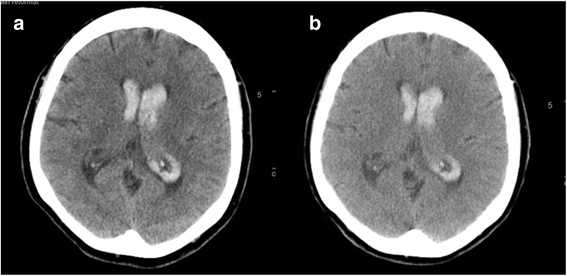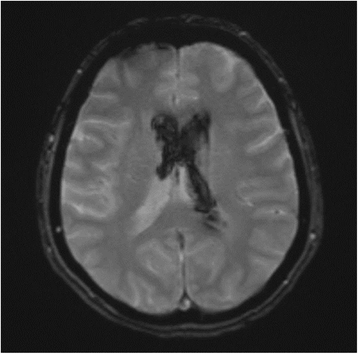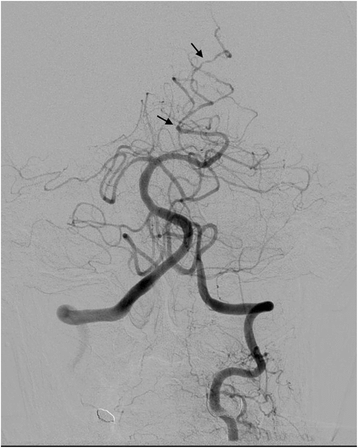Reversible cerebral vasoconstriction syndrome presenting as an isolated primary intraventricular hemorrhage
- PMID: 32922872
- PMCID: PMC7398312
- DOI: 10.1186/s41016-018-0118-7
Reversible cerebral vasoconstriction syndrome presenting as an isolated primary intraventricular hemorrhage
Abstract
Background: Primary intraventricular hemorrhage is an uncommon cause of stroke and is often associated with longstanding, uncontrolled hypertension. Reversible cerebral vasoconstriction is also an uncommon condition characterized by reversible constriction of intracerebral vessels, which can lead to ischemic or hemorrhagic strokes.
Case presentation: We describe a case of isolated primary intraventricular hemorrhage secondary to reversible cerebral vasoconstriction syndrome triggered by pseudoephedrine.
Conclusions: Reversible cerebral vasoconstriction syndrome is a rare cause of primary intraventricular hemorrhage and should be considered in the differential in angiography-negative IVH when there is a history of vasoactive substance use.
Keywords: Primary intraventricular hemorrhage; Pseudoephedrine; Reversible cerebral vasoconstriction syndrome.
© The Author(s) 2018.
Conflict of interest statement
Competing interestsThe authors declare that they have no competing interests.
Figures



Similar articles
-
Progressive manifestations of reversible cerebral vasoconstriction syndrome presenting with subarachnoid hemorrhage, intracerebral hemorrhage, and cerebral infarction.J Korean Neurosurg Soc. 2014 Nov;56(5):419-22. doi: 10.3340/jkns.2014.56.5.419. Epub 2014 Nov 30. J Korean Neurosurg Soc. 2014. PMID: 25535520 Free PMC article.
-
Reversible Cerebral Vasoconstriction Syndrome and Posterior Reversible Encephalopathy Syndrome Presenting with Deep Intracerebral Hemorrhage in Young Women.J Cerebrovasc Endovasc Neurosurg. 2015 Sep;17(3):239-45. doi: 10.7461/jcen.2015.17.3.239. Epub 2015 Sep 30. J Cerebrovasc Endovasc Neurosurg. 2015. PMID: 26523259 Free PMC article.
-
Delayed cerebral ischemia associated with reversible cerebral vasoconstriction in a patient with Moyamoya disease with intraventricular hemorrhage: Case report.Neuroradiol J. 2015 Jun;28(3):322-4. doi: 10.1177/1971400915592553. Neuroradiol J. 2015. PMID: 26246103 Free PMC article.
-
Reversible cerebral vasoconstriction syndrome.Handb Clin Neurol. 2014;121:1725-41. doi: 10.1016/B978-0-7020-4088-7.00111-5. Handb Clin Neurol. 2014. PMID: 24365443 Review.
-
Intracerebral hemorrhage associated with oral phenylephrine use: a case report and review of the literature.J Stroke Cerebrovasc Dis. 2014 Oct;23(9):2296-300. doi: 10.1016/j.jstrokecerebrovasdis.2014.04.018. Epub 2014 Aug 23. J Stroke Cerebrovasc Dis. 2014. PMID: 25156786 Free PMC article. Review.
Cited by
-
Reversible Cerebral Vasoconstriction Syndrome Secondary to Escitalopram.Clin Med Res. 2024 Dec;22(4):222-226. doi: 10.3121/cmr.2025.1864. Clin Med Res. 2024. PMID: 39993827 Free PMC article.
-
Effect of Cinepazide Maleate on Serum Inflammatory Factors of ICU Patients with Severe Cerebral Hemorrhage after Surgery.Evid Based Complement Alternat Med. 2021 Oct 28;2021:6562140. doi: 10.1155/2021/6562140. eCollection 2021. Evid Based Complement Alternat Med. 2021. PMID: 34745295 Free PMC article.
-
Ischemic Stroke Associated with Chronic Xylometazoline Nasal Spray Misuse: A Rare Avoidable Adverse Event.Ann Indian Acad Neurol. 2021 Mar-Apr;24(2):304-307. doi: 10.4103/aian.AIAN_291_20. Epub 2020 Jul 8. Ann Indian Acad Neurol. 2021. PMID: 34220102 Free PMC article. No abstract available.
-
Clinical Characteristics of COVID-19-Related Reversible Cerebral Vasoconstriction Syndrome: A Systematic Review of Case Series.J Clin Med. 2025 Jan 14;14(2):487. doi: 10.3390/jcm14020487. J Clin Med. 2025. PMID: 39860493 Free PMC article. Review.
References
Publication types
LinkOut - more resources
Full Text Sources
